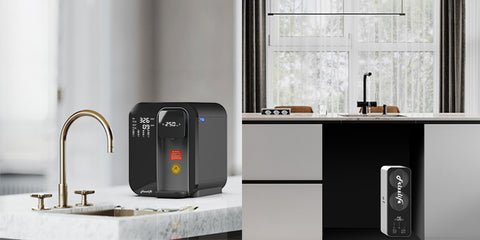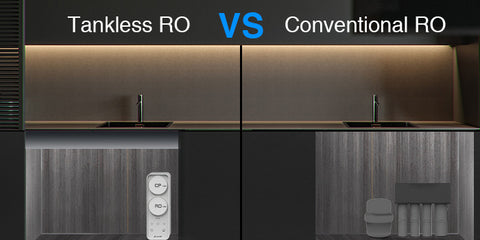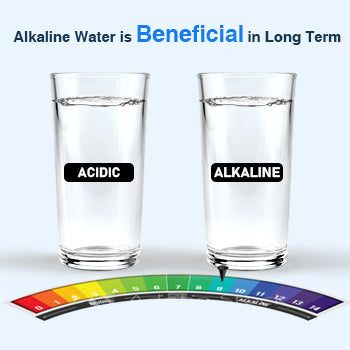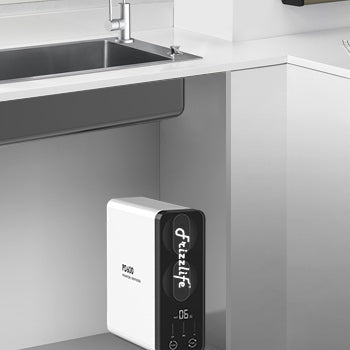|
|
|
Even if you didn’t know about any of this before, having a basic understanding about TDS, EHM and OOHM will help you have better appreciation for your water quality and how the right water filter is going to be so crucial. From there, you can start taking a look at the natural water that you have and then make the right choice when you are getting a water filter to correct it. The good news is that water filtration experts are well-versed in all of this and will help you find just the right one for your particular water needs.
|
1.Under sink RO vs. Countertop RO
|
|
The space availability in your kitchen/workplace determines your preference of choosing from countertop RO and under sink RO. Generally speaking, the under sink Reverse Osmosis system requires sufficient space under your sink for its multistage filter cartridge set and a bulky water tank. Most of them need electricity to pump up and have moderately complex water connections with your water supply pipes.
|
|
The counter top Reverse Osmosis requires you have corresponding space above your sink. It can either be connected to your water supply lines in kitchen/bathroom or independently has an attached water pitcher without any water line connections. Frizzlife offers a “portable” countertop RO solution -- WA99, which is featured with so-called ZERO installation. Everything you need is a general socket to plug in the system; fill in the inbuilt tank of the system with your tap water and you are able to get fresh pure water with a single tap on its screen panel.
|
 |
2.Tankless RO vs. Conventional RO
|
|
In terms of the under sink reverse osmosis, you are now having even more choices given the advanced no-tank design of the RO systems and massive types of conventional reverse osmosis system with pressure tanks on the market. The “classic” kind of the reverse osmosis systems that rely on a pressurized tank that will store the pure water until it is needed. There is a combination of pressurized air and water in the tank and it’ll deliver it quickly and on-demand when you turn the tap on. Since this is the conventional way that it works, it’ll be most cost-effective and you won’t need anything like a booster pump to get the pressure you need. They also store water for you, which is great in case of a power outage.
|
|
There are many perks, including the fact that they’re cost-effective, available just about everywhere, and have a long track record going for them as far as their integrity and even maintenance needs.
|
|
Even if you didn’t know about any of this before, having a basic understanding about TDS, EHM and OOHM will help you have better appreciation for your water quality and how the right water filter is going to be so crucial. From there, you can start taking a look at the natural water that you have and then make the right choice when you are getting a water filter to correct it. The good news is that water filtration experts are well-versed in all of this and will help you find just the right one for your particular water needs.
|
|
The more modern option, a tankless RO system is going to work the same way, except it isn’t going to pre filter the water for you. It’ll work on-demand, essentially, using a thicker membrane with higher capacity to do the same filtering you’re expecting. The abandon of the water tank largely save the space under the sink while eliminate the second pollution which may brought by the unventilated water tank. Some feel as though tankless reverse osmosis systems deliver better tasting water because the filter membrane is better and thicker, hypothetically catching more than tank-using systems.
|
 |
3.Alkaline & Remineralization
|
|
For decades, the reverse osmosis systems have become a universal choice for indoor water treatment, which could effectively brings you pure water from home. The reverse osmosis system literally removes not only harmful contaminants but also beneficial minerals and ions from water which is essential to our human both on daily basis. Moreover, the pure water is slightly acidic which may lead to a bit acidic taste of the water whereas the human body works under a weak alkaline condition. Consequently, there raises a discussion on health issues related with long term pure water intake.
|
|
To cope with the new market needs and trend, many brands of reverse osmosis systems comes with a new solution of post alkaline carbon-mineral filters. By adding back minerals and active ions, the pH level of the RO water can be adjusted to weak alkaline and the water taste will be further polished. Some doubt on the authenticity of the alkaline statement and was suspecting the level of the mineral restore and stick to pure water solution. Thus, to choose from alkaline function of the RO system, you need to make sure the safety of the medium being used.
|
 |
4.Filtration Capacity
|
|
The filtration capacity of the RO membrane is another key aspect you need to pay attention to. The filtration capacity is generally measured based on Gallons per Day (GPD). Basically, the higher the Capacity of the Reverse Osmosis membrane, the faster the water outflow would be. For example, the most universal conventional RO systems have a 50 GPD capacity which could product 50 Gal. of water per day, equivalent to 0.035 Gal per Minute. In other words, after the filtered water stored in the water tank being exhausted, it will take more than 126 sec to fill a cup of 300 ml water. The low working capacity of the conventional system thus is the main reason for the water storage tank.
|
|
With advanced technology, the RO system now are having more capacity choices from 50 GPD to 1000 GPD. The prices also varies in accordance with the capacity.
|
 |
5.Other Features You Might Be Interested In
|
|
There are other features such as TDS monitor, Filter life reminder and installation & replacement simplicity, etc the Reverse Osmosis system could have as add-ons to its basic function. In most cases, you will call a plumber to install the RO system or replace the inner cartridges for you due to complexity of the water connections and vague evaluation of the filter life. The most up-to-date Reverse Osmosis Water Filter Systems on the market thus make an improvement on all these weaknesses of traditional RO systems by abandoning water tank, embed TDS monitor and filter life reminder and also simplify the installation steps which allows customers to install the system and change the filter cartridges all by themselves.
|
 |
Choosing between the options
|
|
In conclusion, there are lots of metrics you could rely on when choosing the reverse osmosis systems for your home and work places. It highly depends on your personal preference as well as your budget target.
|
| Sometimes conventional does it best. Since it’s been around for a while, a conventional reverse osmosis system is simple, cost-effective, and tried and tested. When you want a “sure thing” in your choice, this is pretty much the best you’ll get. However, a tanked system also takes up a lot of space in your home. If you are limited in space, then this is something to consider.
|
| A tankless system is often a great option for those that want to save water and have small needs on water filtrating itself. They don’t take up a lot of space, but also quickly can be a problem with filtering speed and pressure. Tankless options are often great for smaller homes and those with steady, strong water pressure.
|
| There are a few perks and drawbacks to these water system options. Understanding which one is best for you focuses as much on understanding the difference between these options, as well as what is going to work best for your space and water needs, and more.
|
| At the end of the day, the choice is yours to make and it’s often based on what is best for your budget, space, and use. This is purely meant to help you understand what you’re getting with each choice!For any further water filter system related questions, please feel free to contact Frizzlife anytime.
|
 |
Research used:
|
|
https://www.synovislife.com/reverse-osmosis-tank-vs-tankless-which-is-the-one-for-you/
|
The Key Parameters of Choosing a Reverse Osmsosis System, and the Main Difference Between Tankless Reverse Osmosis System and Conventional Reverse Osmosis System

Alice L |
